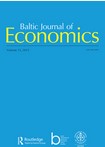Asymmetries in effects of domestic inflation drivers in the Baltic States: a Phillips curve-based nonlinear ARDL approach
Asymmetries in effects of domestic inflation drivers in the Baltic States: a Phillips curve-based nonlinear ARDL approach
Author(s): Vladimir Mihajlović, Gordana MarjanovićSubject(s): National Economy, Labor relations, Economic policy, Comparative politics, Methodology and research technology, Socio-Economic Research
Published by: BICEPS/SSE Riga
Keywords: Inflation; output gap; unemployment gap; nonlinear ARDL model; the Baltic States;
Summary/Abstract: This study investigates asymmetry in the impact of domestic inflation drivers in the Baltic States, focusing on the output gap and unemployment gap. We aim to reveal how positive and negative changes in these economic activity indicators affect the inflation rate by employing a nonlinear autoregressive distributed lag approach (NARDL) and the Phillips curve. Empirical results demonstrate the long-run asymmetry as inflation in Estonia and Lithuania responds more significantly to positive changes in the output gap, whereas negative changes in the unemployment gap exhibit a stronger long-run impact on inflation in all three countries. These findings mainly suggest some extent of downward price rigidity in the Baltic economies, indicating a nonlinear Phillips curve and relatively large costs of disinflation policy directed to aggregate demand reduction. Further analysis reveals that increasing downward nominal wage flexibility could reduce these asymmetries in Estonia and, to a lesser extent, in Latvia and Lithuania.
Journal: Baltic Journal of Economics
- Issue Year: 20/2020
- Issue No: 1
- Page Range: 94-116
- Page Count: 23
- Language: English

